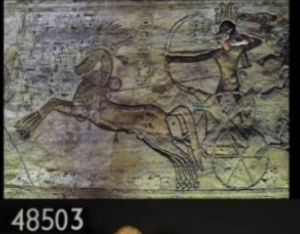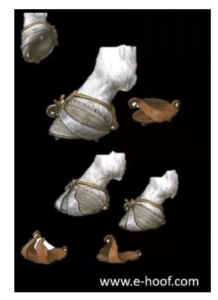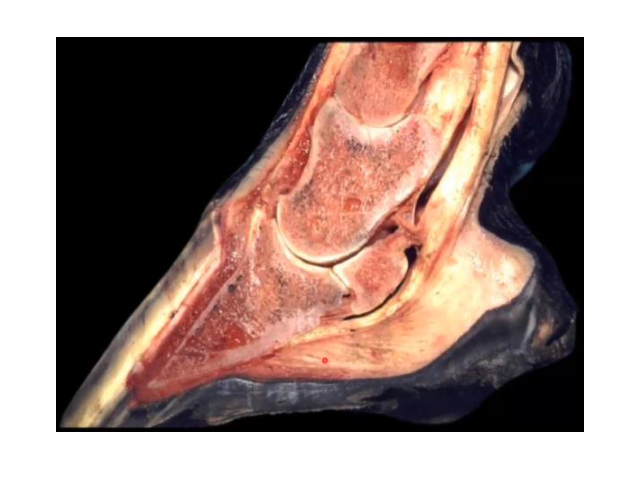Part 1: Evolution of the Horse

Jurassic Period – Eohippus:
The primitive horse, known as Eohippus, was small in size and fed on small vegetation and fruits. At this stage, the animal had four toes, but over time, its anatomical structure and hooves evolved to enhance its survival, as it was prey and needed to run to escape predators. The bones of the four toes began to become rudimentary, and eventually, the hoof developed, leaving only vestiges of the metacarpal/metatarsal bones. The “chestnut,” which we now know as a small protuberance above the hoof, is also considered an evolutionary remnant, having been a bony structure in the past.
Another important characteristic, which still persists in many horses today, is their feeding pattern: they graze for 16 to 18 hours a day. This reflects their anatomical and physiological conditions, as the horse moves a lot throughout the day, eats in small amounts, and is always prepared to run if necessary.
The domestication of the horse occurred between 5,000 and 4,500 years before Christ in the Eurasian region. Initially, horses were used for food and hunting, but over time, they began to be employed in various other activities, becoming essential in many cultures and societies throughout history.
Various civilizations, in different contexts such as wars, agriculture, transportation, and more, have used the horse in ways that were essential to their development. This highlights the crucial role the horse played in the evolution of civilizations throughout history.
Today, in addition to many other functions, the horse is also used as a hobby in equestrian sports.
Over time, the horse has primarily been employed as a draft animal, for transportation, and in battles.
Considering the history and development of the horse, it is important to recognize that many peoples contributed to the discovery and improvement of aspects and tools related to the management and use of horses.
Part 2: The First Horseshoes – Egyptians and Persians, between 1,700 – 1,550 B.C.
Purpose of Horseshoe Use:
The purpose of using horseshoes is to protect the horse’s hooves, especially considering the type of terrain the animal encounters, the intensity of exercises and movements, and the growth of the hooves. When hoof wear exceeds its growth rate, the hoof may not be prepared for this wear, making it susceptible to changes in the hoof wall, causing pain and, consequently, lameness.



History:
- The Egyptians used animal hides for clothing and to protect the hooves.
- Genghis Khan (12th century) made use of horseshoes for cavalry.
- The first horseshoes with nails likely appeared in China.
- The Romans invented the “hipposandal” (100-200 A.D.) for hoof protection. In this way, farriers played an important role in society as they worked with the iron used for the horseshoes.
- Other civilizations also developed devices to protect horses’ feet. The Orientals, for example, invented straw sandals, which were common in remote areas of Japan until the 20th century.
- The first horseshoes with nails date back to around 400 A.D.
- The first books about horseshoeing began to appear around the 16th century.
- Blundeville (1566) – “Fit the shoe to the foot, not the foot to the shoe.”
- Solleysel (1664) – Describes the use of hoof guards.
- Signs of lameness
- Bridges (1751): Describes the “elastic mechanism of the hoof,” explaining that the hoof is a mobile structure essential for development, impact absorption, blood flow, and overall hoof health.
- Origin of the famous phrase “No foot, no horse”: Poor distribution of support among the four hooves (such as from an injury to one hoof) can lead to systemic diseases and affect the animal as a whole. This can result in issues in the other previously healthy hooves, leading to conditions like laminitis.
- Latin word “ferrum”: Steel.
- Latin word “ferraius”: Ironworker – blacksmith.
- French word “ferrer”: To shoe a horse.
- William the Conqueror: Introduced horseshoes with nails from France to Great Britain in 1066 A.D.
Part 3: Women in Horseshoeing and Historical Development
- Women in Horseshoeing:
- In 1916, during World War I;
- France, 1928;
- Horseshoeing was more developed in Europe.
- The Farriers:
- Farriers forged horseshoes using steel bars.
- Historical Context:
- It’s important to remember that horses are not native to the Americas; they were brought over during colonization.
- 1934 – Henry Burden (Scottish engineer):
- Patented the first machine for mass-producing horseshoes, with pre-defined models.
- The machine produced 60 horseshoes per minute.
- During the American Civil War, Burden provided horseshoes for over 825,000 horses belonging to the Union.
- The Worshipful Company of Farriers:
- Founded in London in 1356, this farrier company emphasizes the historical importance of the profession.
- The company still exists today, and the farrier profession is regulated in England.
- The Role of Horses in Wars:
- Horses played a crucial role in various wars, especially during World War I.
- During this time, veterinary hospitals were already in place to assist animals involved in the wars. One such hospital was the British Army Veterinary Corps, which treated around 500 horses per day, addressing various pathologies.
- Post-War and the Use of Horses:
- After the war, horses became more commonly used as a hobby and for agricultural purposes. Today, they play an important socio-economic role in society.
- Horseshoeing:
- Today, horseshoeing techniques are highly advanced and based on scientific research. Anatomy and the study of podiatry are essential for proper horseshoeing.
- Changes in the hoof directly affect the overall well-being of the horse.

